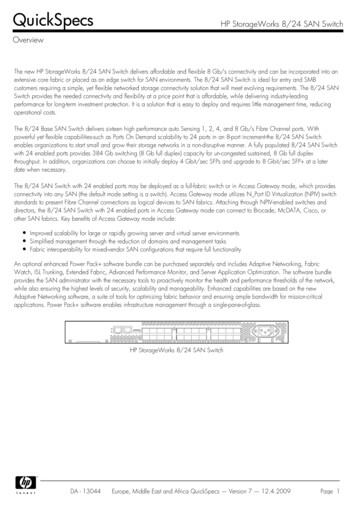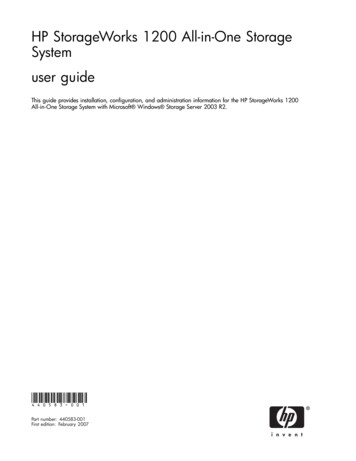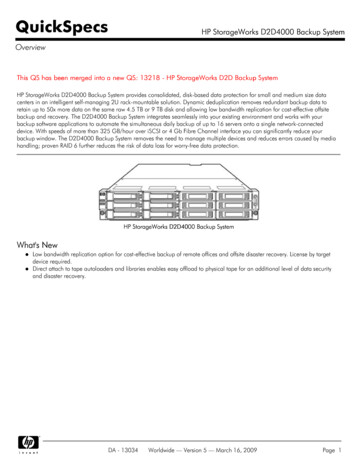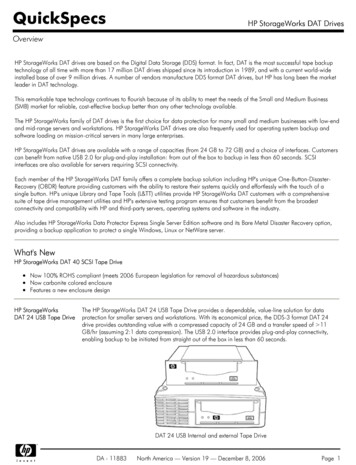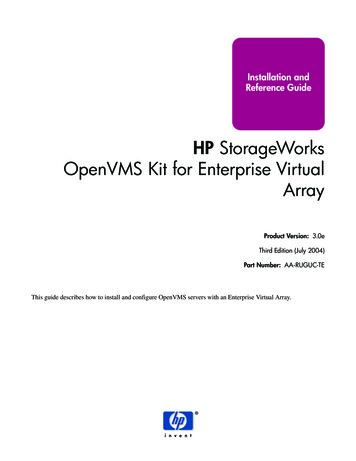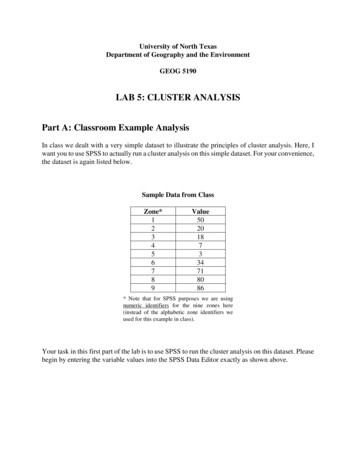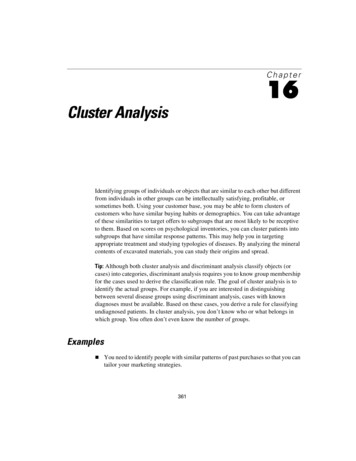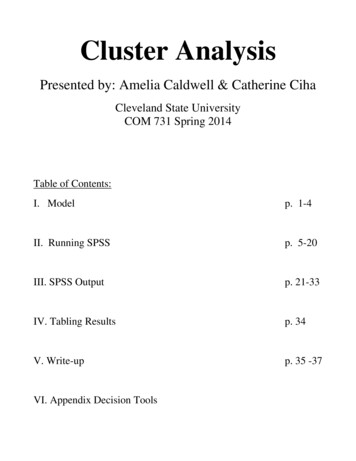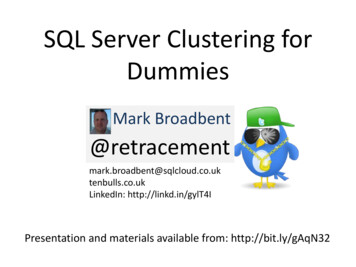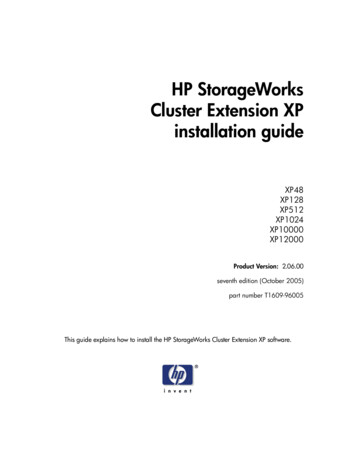
Transcription
HP StorageWorksCluster Extension XPinstallation guideXP48XP128XP512XP1024XP10000XP12000Product Version: 2.06.00seventh edition (October 2005)part number T1609-96005This guide explains how to install the HP StorageWorks Cluster Extension XP software.
Copyright 2003-2005 Hewlett-Packard Development Company, L.P., all rights reservedHewlett-Packard Company makes no warranty of any kind with regard to this material, including, but not limitedto, the implied warranties of merchantability and fitness for a particular purpose. Hewlett-Packard shall not beliable for errors contained herein or for incidental or consequential damages in connection with the furnishing,performance, or use of this material.This document contains proprietary information, which is protected by copyright. No part of this document may bephotocopied, reproduced, or translated into another language without the prior written consent of Hewlett-Packard.The information contained in this document is subject to change without notice.All product names mentioned herein may be trademarks of their respective companies.Hewlett-Packard Company shall not be liable for technical or editorial errors or omissions contained herein. Theinformation is provided “as is” without warranty of any kind and is subject to change without notice. The warrantiesfor Hewlett-Packard Company products are set forth in the express limited warranty statements accompanying suchproducts. Nothing herein should be construed as constituting an additional warranty.Printed in the U.S.A.HP StorageWorks Cluster Extension XP Installation Guideproduct version: 2.06.00seventh edition (October 2005)part number: T1609-960052HP StorageWorks Cluster Extension XP Installation Guide
ContentsAbout this guide 9Intended audience 10Supported arrays 10Related documentation 11Other resources 11Getting help 12HP technical support 12HP storage website 13HP authorized reseller 13Document conventions 14Terminology conventions 15Revision history 16Warranty statement 181ContentsIntroduction 21Introducing Cluster Extension XP 22Cluster Extension XP configurations 22One-to-one configurations 23Consolidated disaster recovery site configuration 25Supported Continuous Access XP configurations and fence levelsInstallation prerequisites 27Software versions and supported Cluster Extension XP features 29Disk array firmware and software dependencies 29Pair/resync monitor 30Fast failback feature of Continuous Access XP (Extension) 30Quorum service (Microsoft Cluster Service only) 31Rolling disaster protection 31263
234Cluster Extension XP licensing 33Product licensing 34About your Entitlement Certificate 34Overview of retrieving license keys 35Getting an evaluation license extension 35Using AutoPass to retrieve permanent license keysRetrieving license keys over the Internet 37Requesting license keys by e-mail or fax 46Importing a license key into AutoPass 53Getting a 60-day trial extension 59License options 60Report license key 60Backup license file 61Remove license key 64Recover license key 66clxautopass command line utility 67Installing the Instant-on license 67Importing a license key from a file 6735Installing Cluster Extension XP in IBM HACMP environmentsPrerequisites 70Supported versions 70HP StorageWorks Auto Path XP for AIX 70RAID Manager XP instances 71RAID Manager XP device groups 71RAID Manager XP startup 71RAID Manager XP configuration 72LVM configuration 74HACMP 74Installing Cluster Extension XP 75Pair/resync monitor configuration 77Remote access hosts file 77Configuring the port for the pair/resync monitor remotecommunications 77Configuring Cluster Extension XP resources 78Removing Cluster Extension XP 79Upgrading Cluster Extension XP 8069HP StorageWorks Cluster Extension XP Installation Guide
4ContentsInstalling Cluster Extension XP in Microsoft Cluster Serviceenvironments 81Installation Overview 83The Cluster Extension XP quorum service 83Disk configuration for Microsoft Cluster Service with quorumservice 84Partitioning RAID Manager XP command devices and quorum servicecontrol disks 86Pairing all disks in the cluster environment 87Prerequisites 88Supported versions 89Custom Volume Size (CVS) Configuration on XP disk arrays 89Secure Path/MPIO 89RAID Manager XP instances 90RAID Manager XP device groups 90RAID Manager XP command devices 91Installation Roadmap 92Preparing data centers for quorum service installation 93Create CVS volumes in the disk arrays and map them to servers 93Partition physical disks on the first server 94Create RAID Manager configuration file and pair disk pairs 96Reboot and check for GUIDs on all nodes 97Install Microsoft Cluster Service on all nodes in the second datacenter 99Install Cluster Extension XP 100Installing the quorum service 102Installing Cluster Extension XP Command Line Interface 107Installing the Cluster Extension XP external arbitrator 108Procedure 108Problems during Cluster Extension XP external arbitratorinstallation 110Identifying the external arbitrator in the Active Directory 111Troubleshooting 112Log files 112Resolving quorum service problems 114Installing Cluster Extension XP resource types 116Configuring Cluster Extension XP resources 118RAID Manager XP startup at system boot 1195
Pair/resync monitor configuration 120Remote access hosts file 120Configuring the port for the pair/resync monitor remotecommunications 120Registering the Cluster Extension XP resource manually 121Maintenance and repair of Cluster Extension XP 122Modify function 122Repair function 122Remove function 123Removing your Cluster Extension XP installation 124Removing the Cluster Extension XP resource type 124Disabling the Cluster Extension XP resource DLL 124Removing the quorum service 125Removing the Cluster Extension XP external arbitrator 127Upgrading Cluster Extension XP 128Upgrading Cluster Extension XP: offline upgrade 128Upgrading from Cluster Extension XP version 2.03.00 and later only:online upgrade 12956Installing Cluster Extension XP in VCS environments 135Prerequisites 136Supported versions 136RAID Manager XP instances 136RAID Manager XP device groups 137RAID Manager XP startup 138VERITAS Volume Manager configuration 138Installing Cluster Extension XP 139Pair/resync monitor configuration 140Remote access hosts file 140Configuring the port for the pair/resync monitor remotecommunications 140Log level reporting 141Including the Cluster Extension resource type 142Changing the default agent configuration 144Disabling the Cluster Extension XP agent 145Removing Cluster Extension XP 146Removing the HP AutoPass License Components 146Upgrading Cluster Extension XP 147HP StorageWorks Cluster Extension XP Installation Guide
6Installing Cluster Extension XP in Serviceguard for Linuxenvironments 149Prerequisites 150Supported versions 150HP StorageWorks Secure Path 150RAID Manager XP instances 151RAID Manager XP device groups 151RAID Manager XP startup 152Logical Volume Manager configuration 152Installing Cluster Extension XP 154Pair/resync monitor configuration 155Remote access hosts file 155Configuring the port for the pair/resync monitor remotecommunications 155Including Cluster Extension XP in a Serviceguard package 156Removing Cluster Extension XP 157Upgrading Cluster Extension XP for Serviceguard for Linux 158GlossaryIndexContents1591637
8HP StorageWorks Cluster Extension XP Installation Guide
About this guideCluster Extension XP software is used to create a disaster-tolerantenvironment using two or more data centers. Cluster Extension XP enablescluster software to provide automatic failover for applications whose data iscontinuously mirrored from a local XP disk array to a remote XP disk array.This guide explains how to install Cluster Extension XP. It assumesclustered systems are connected to a disaster recovery, array-basedmirroring system where mirroring is provided by HP StorageWorksContinuous Access XP.This guide applies to the following versions of Cluster Extension XP: Microsoft Windows: Cluster Extension XP version 2.06.00 Linux Red Hat: Cluster Extension XP version 2.06.00 SuSE Linux: Cluster Extension XP version 2.06.00 Solaris: Cluster Extension XP version 2.05.01 IBM AIX: Cluster Extension XP version 2.02.00Please contact your HP representative for the latest information onsupported configurations and versions.About this guide9
Intended audienceThis guide is written for those responsible for maintaining the clusterenvironment and managing the storage subsystems.This guide is intended for system administrators who have anunderstanding of: disk arrays and RAID technology cluster software configuration operating systems, including commands and utilities related software: HP StorageWorks Continuous Access XP, HPStorageWorks Business Copy XP and HP StorageWorks RAIDManager XPSupported arraysUnless otherwise noted, the term disk array refers to these disk arrays: HP StorageWorks Disk Array XP48 HP StorageWorks Disk Array XP128 HP StorageWorks Disk Array XP512 HP StorageWorks Disk Array XP1024 HP StorageWorks XP10000 Disk Array HP StorageWorks XP12000 Disk Array10HP StorageWorks Cluster Extension XP Installation Guide
Related documentationFor information about disk arrays, please refer to the owner’s manuals.For related product documentation, see the HP web site www.hp.com): HP StorageWorks Cluster Extension XP: User’s Guide HP StorageWorks RAID Manager: User’s Guide HP StorageWorks Continuous Access XP: User’s Guide HP StorageWorks Business Copy XP: User’s Guide HP StorageWorks Command View XP: User’s Guide HP StorageWorks Command View XP Advanced Edition DeviceManager Web Client User's Guide HP StorageWorks XP Remote Web Console User Guide HP StorageWorks Disk Array XP Operating System ConfigurationGuide: AIX HP StorageWorks Disk Array XP Operating System ConfigurationGuide: Sun Solaris HP StorageWorks Disk Array XP Operating System ConfigurationGuide: Windows 2000/2003 HP StorageWorks Disk Array XP Operating System ConfigurationGuide: LinuxOther resourcesThe following websites contain related information: Serviceguard for Linux. See the HP High Availability web site:http://docs.hp.com/en/ha.html RS/6000 and HACMP. See the IBM web site:www-1.ibm.com/servers/aix/library VERITAS Cluster Server. See the VERITAS web site:support.veritas.com Microsoft Cluster Service. See these Microsoft web ologies/clusteringAbout this guide11
Getting helpIf you still have a question after reading this guide, contact an HPauthorized service provider or access our web site:www.hp.comFor the most current information about this product, visit the followingsupport web site:www.hp.com/support/clxxpHP technical supportIn North America, call technical support at 1-800-633-3600, available 24hours a day, 7 days a week.Outside North America, call technical support at the location nearest you.The HP web site lists telephone numbers for worldwide technical supportat: http://www.hp.com/support. From this web site, select your country.Be sure to have the following information available before calling: technical support registration number (if applicable) product serial numbers product model names and numbers applicable error messages operating system type and revision level detailed, specific questionsFor continuous quality improvement, calls may be recorded or monitored.12HP StorageWorks Cluster Extension XP Installation Guide
HP storage websiteFor the most current information about HP StorageWorks XP products,visit: l.For information about product availability, configuration, and connectivity,contact your HP support representative.HP authorized resellerTo reach HP sales or find a local authorized reseller of HP products, call1-800-282-6672 or visit the HP How To Buy web htmlYou can also find HP sales and resellers at http://www.hp.com. ClickContact HP.About this guide13
Document conventionsConventionElementBlue text (Figure 1)Blue text represents a cross-reference. In the online version of this guide,the reference is linked to the target.BoldBold text represents application names, file names, menu items, dialogbox titles, buttons, key names, field names, and literal values that youtype exactly as shown.ItalicsItalic type indicates that you must supply a value. Italic type is also usedfor manual titles.Blue underlined sans seriffont (www.hp.com)Underlined, blue text represents a website on the Internet. In the onlineversion of this guide, the reference is linked to the target.monospace fontMonospace font denotes user input and system responses, such as outputand messages.ExampleThe word “example” in italics denotes an example of input or output.[]Square brackets indicate an optional parameter.{}Braces indicate that you must specify at least one of the listed options. A vertical bar separates alternatives in a list of options.14HP StorageWorks Cluster Extension XP Installation Guide
Terminology conventionsCluster software vendors use different terms for clustering and disasterrecovery processes and for their cluster software components. Because ofthese variations in terminology, it is important to clarify the terms used inthis guide. This guide uses the following terminology conventions:application service This is the unit of granularity for a failover or failbackoperation. It includes all necessary resources that mustbe present for the application.For example, a file share must have a disk, a mountpoint (or drive letter) and an IP address to be consideredan application service. A disk is a necessary resourcefor the application service. Depending on the clustersoftware, application services can depend on each otherand run in parallel on the same system or on differentsystems.Vendor equivalent terms:HACMP: resource groupMicrosoft Cluster Service: resource groupSG-LX (Serviceguard): packageVCS: service groupresourceThe smallest unit in an application service. It describesthe necessary parts to build an application service. Theimplementation of such resources in cluster software isvendor-specific. Some vendors (such as IBM or HP) donot allow accessing the chains between dependentresources.Vendor equivalent termsHACMP: resourceMicrosoft Cluster Service: resourceSG-LX (Serviceguard): packageVCS: resourcestartup/shutdown This refers to starting and stopping application servicesor resources. Only Microsoft and Veritas allow thestarting and stopping of a single resource.About this guide15
Revision history16February 2001First release.March 2001General corrections.July 2001Added MSCS support.November 2001Added quorum filter-service for MSCS onXP512/XP48.May 2002Updated content for version 1.03 of all ClusterExtension products.Updated content for version 1.04.00 of ClusterExtension for MSCS.Added support for Serviceguard on Linux.Updated content for version 1.1 of ClusterExtension XP quorum service with externalarbitrator.September 2002Updated content for version 2.00.Changed product terminology from MSCS toMicrosoft Cluster Service.Revised the quorum service installationprocedure for Microsoft Cluster Service.December 2002Updated content for version 2.01 for VCS andServiceguard.Added graphical user interface installationprocedure.January 2003Updated content for version 2.01 for WindowsGUI.April 2003Updated content for version 2.02.November 2003Updated content for versions 2.02 and 2.03.Added support for SUSE Linux and Windows2003. Removed support for XP256.March 2004Modified document for version 2.04.HP StorageWorks Cluster Extension XP Installation Guide
About this guideAugust 2004Updated for version 2.05.00 and AutoPass.October 2005Updated for version 2.06.00.17
Warranty statementHP warrants that for a period of ninety calendar days from the date ofpurchase, as evidenced by a copy of the invoice, the media on which theSoftware is furnished (if any) will be free of defects in materials andworkmanship under normal use.DISCLAIMER. EXCEPT FOR THE FOREGOING AND TO THEEXTENT ALLOWED BY LOCAL LAW, THIS SOFTWARE ISPROVIDED TO YOU “AS IS” WITHOUT WARRANTIES OF ANYKIND, WHETHER ORAL OR WRITTEN, EXPRESS OR IMPLIED.HP SPECIFICALLY DISCLAIMS ANY IMPLIED WARRANTIESOR CONDITIONS OF MERCHANTABILITY, SATISFACTORYQUALITY, NON-INFRINGEMENT, TITLE, ACCURACY OFINFORMATIONAL CONTENT, AND FITNESS FOR APARTICULAR PURPOSE. Some jurisdictions do not allow exclusionsof implied warranties or conditions, so the above exclusion may not applyto you to the extent prohibited by such local laws. You may have otherrights that vary from country to country, state to state, or province toprovince.WARNING! YOU EXPRESSLY ACKNOWLEDGE AND AGREETHAT USE OF THE SOFTWARE IS AT YOUR SOLE RISK. HPDOES NOT WARRANT THAT THE FUNCTIONS CONTAINED INTHE SOFTWARE WILL MEET YOUR REQUIREMENTS, OR THATTHE OPERATION OF THE SOFTWARE WILL BE UNINTERRUPTED,VIRUS-FREE OR ERROR-FREE, OR THAT DEFECTS IN THESOFTWARE WILL BE CORRECTED. THE ENTIRE RISK AS TO THERESULTS AND PERFORMANCE OF THE SOFTWARE IS ASSUMEDBY YOU. HP DOES NOT WARRANT OR MAKE ANYREPRESENTATIONS REGARDING THE USE OR THE RESULTS OFTHE USE OF THE SOFTWARE OR RELATED DOCUMENTATION INTERMS OF THEIR CORRECTNESS, ACCURACY, RELIABILITY,CURRENTNESS, OR OTHERWISE. NO ORAL OR WRITTENINFORMATION OR ADVICE GIVEN BY HP OR HP’S AUTHORIZEDREPRESENTATIVES SHALL CREATE A WARRANTY.18HP StorageWorks Cluster Extension XP Installation Guide
LIMITATION OF LIABILITY. EXCEPT TO THE EXTENTPROHIBITED BY LOCAL LAW, IN NO EVENT INCLUDINGNEGLIGENCE WILL HP OR ITS SUBSIDIARIES, AFFILIATES,DIRECTORS, OFFICERS, EMPLOYEES, AGENTS ORSUPPLIERS BE LIABLE FOR DIRECT, INDIRECT, SPECIAL,INCIDENTAL, CONSEQUENTIAL, PUNITIVE OR OTHERDAMAGES (INCLUDING LOST PROFIT, LOST DATA, ORDOWNTIME COSTS), ARISING OUT OF THE USE, INABILITYTO USE, OR THE RESULTS OF USE OF THE SOFTWARE,WHETHER BASED IN WARRANTY, CONTRACT, TORT OROTHER LEGAL THEORY, AND WHETHER OR NOT ADVISEDOF THE POSSIBILITY OF SUCH DAMAGES. Your use of theSoftware is entirely at your own risk. Should the Software prove defective,you assume the entire cost of all service, repair or correction. Somejurisdictions do not allow the exclusion or limitation of liability forincidental or consequential damages, so the above limitation may not applyto you to the extent prohibited by such local laws.NOTE. EXCEPT TO THE EXTENT ALLOWED BY LOCAL LAW,THESE WARRANTY TERMS DO NOT EXCLUDE, RESTRICT ORMODIFY, AND ARE IN ADDITION TO, THE MANDATORYSTATUTORY RIGHTS APPLICABLE TO THE LICENSE OF THESOFTWARE TO YOU; PROVIDED, HOWEVER, THAT THECONVENTION ON CONTRACTS FOR THE INTERNATIONALSALE OF GOODS IS SPECIFICALLY DISCLAIMED AND SHALLNOT GOVERN OR APPLY TO THE SOFTWARE PROVIDED INCONNECTION WITH THIS WARRANTY STATEMENT.About this guide19
20HP StorageWorks Cluster Extension XP Installation Guide
1IntroductionThis chapter provides instructions for installing HP StorageWorks ClusterExtension XP for Linux, Microsoft Windows 2000 and Windows 2003,Sun Solaris, or IBM AIX servers connected to XP disk arrays in aContinuous Access XP configuration.Introduction21
Introducing Cluster Extension XPCluster Extension XP improves the performance and safety of your diskarray by: enabling write-protected XP disk array disk sets checking disk status information in case of a server or complete sitefailure, which allows application service recovery even in the worstdisaster.Cluster Extension XP is fully integrated with Serviceguard for Linux,Microsoft Cluster Service, VERITAS Cluster Server (VCS) and IBMHACMP, allowing the cluster administrator to easily integrate XP storagesubsystems.The guide will explain the options available to make your disaster tolerantenvironment as robust as possible and to keep your data always available.Cluster Extension XP configurationsCluster configurations typically consist of two or more server systemsconnected to a shared storage subsystem.Cluster Extension XP allows dispersion of data center resources byenabling cluster systems to take advantage of XP disk arrays configured forContinuous Access XP operations. Cluster Extension XP connects the XPsoftware to control XP disk arrays (and Continuous Access XP) with thecluster software and uses the ability of cluster software to react to systemhardware and application failures.Cluster Extension XP’s behavior is based on four major considerations: Cluster software failover behaviors Cluster Extension XP user settings The fence level configuration (in Continuous Access XP) XP disk status information22HP StorageWorks Cluster Extension XP Installation Guide
Therefore, and because of consistency and concurrency considerations,Cluster Extension XP supports the configurations described below. Thefence level of Continuous Access XP is used to configure the remotereplication feature of an XP disk array environment based on your needsregarding application service availability, data concurrency and replicationperformance.One-to-one configurationsCluster host nodes are split between two geographically separate datacenter sites and use redundant, diversely routed network connections forintracluster communications. Those links must be as reliable as possible toprevent false failover operations or “split-brain” situations.Each cluster host node connected to an XP disk array should haveredundant I/O paths (FC or SCSI) to the XP disk array. Connections to boththe primary (P-VOL) and the secondary (S-VOL) copy of the applicationdisk set are not allowed from the same host.HP recommends a minimum of two cluster host nodes per site. This allowsfor a preferred local failover in case of a system failure. Local failoveroperations are faster than a remote failover between XP disk arrays becausethe mirroring direction of the XP disks does not need to be changed.Cluster Extension XP can be deployed in environments where severalclusters use the same XP disk array pair.Currently, Cluster Extension XP works with Continuous Access XP in thefollowing configurations: Fibre Channel direct connections, using either short wave (550 meters)or long wave (10 km) transceivers. Fibre Channel with switches, short wave, long wave, or extra longwave transceivers can be used up to 200 km, depending on thetransceiver type. Fibre Channel over WDM (wave division multiplexing) can be usedup to 200 km, depending on the WDM vendor specifications. Thisincludes DWDM (Dense wave division multiplexing) and CWDM(coarse wave division multiplexing) technologies.Introduction23
Fibre Channel over IP networks using FC to IP converters. Thisincludes ATM networks using an FC to ATM converter. The IP/ATMnetwork can be public or private, such as T3/E3 lines. The distancesupported by FC over IP/ATM implementation is limited only by theacceptable latency (time delay) of the link. ESCON direct connections or extended connections usingextender/director hardware for distances up to 43 km. (ESCON is notsupported on all array types.) ESCON over WDM is only supported up to 50 km. (This is anESCON limitation and not a WDM limitation.) ESCON or IP/ATM using ESCON to IP/ATM converters. Thedistance supported is limited only by the acceptable latency of the link.Client SystemsUser LAN (carrying heartbeats)Data LAN (carrying heartbeats)Heartbeat LANMANCluster Systemsdata centerinManhattan(ESCON,IPATM,DWDM)data centerinBrooklynOne-to-one configuration24HP StorageWorks Cluster Extension XP Installation Guide
Consolidated disaster recovery site configurationConfigurations that have a single XP disk array in the disaster recovery(DR) data center and up to four other primary XP disk arrays are supportedwith Cluster Extension XP (the logical configuration must be a one-to-oneconfiguration). The restrictions outlined earlier apply also to consolidatedconfigurations.Cluster Extension XP does not support NxM configurations, where theapplication service’s data disk set is spread over two or more XP diskarrays.Consolidated Disaster Recovery site configurationIntroduction25
Supported Continuous Access XP configurations and fence levelsOne-to-one and consolidated configurations support all Continuous AccessXP fence levels: NEVER, DATA, and ASYNC. Fence levels DATA andNEVER implement synchronous replication and are therefore directlyimpacted by the distance of the link. HP recommends not implementingthese fences on links exceeding 100 km. However, each customer shoulddetermine the acceptable impact to their host application I/O.Fence level ASYNC can be implemented on any configuration, but istypically implemented for longer distances.Notes: The Continuous Access XP links must be configured for bidirectionalmirroring and must have redundant, separately routed links for eachdirection. Heartbeat network over DWDM or IP: The cluster heartbeatcommunications could be routed over the same DWDM or IP links asthe Continuous Access XP data traffic. However, the network linksshould be diversely routed to minimize link congestion and reduce thepotential of “split-brain” syndrome attributed to network componentfailures or link failures. Dynamic routing in the wide area network must be transparent to theContinuous Access XP links. Otherwise, dynamic switched networkconnections could lead to suspended XP disk pairs.26HP StorageWorks Cluster Extension XP Installation Guide
Installation prerequisitesEnsure that the following conditions are met before installing your ClusterExtension XP software: Internal LDEVs are mapped to redundant XP Client Host InterfacePorts (CHIPs) and host modes and Fibre Channel port settings havebeen customized. Continuous Access XP links (including all extender hardware) are setup in a redundant, bidirectional configuration. Alternate I/O paths between server system and the XP disk array areset up. The cluster and client networks are set up in a redundantconfiguration. The cluster software is installed on all systems (not required forWindows 2000 and Windows 2003). The cluster is set up and cluster systems can communicate with eachother (not required for Windows 2000 and Windows 2003). HP StorageWorks RAID Manager XP command devices areconfigured. HP StorageWorks RAID Manager XP horcmX.conf files have beencreated and tested. HP StorageWorks RAID Manager XP instances can communicateusing the most reliable network (heartbeat network) and at least onealternate network. RAID Manager versions are the same on all nodes in a cluster. The pair/resync monitor port is set up in the /etc/services file (notrequired for Windows 2000 and Windows 2003). See the HPStorageWorks Cluster Extension XP: User’s Guide. A failover test proved bidirectional communications in the CA XPsetup for all configured XP Control Units (CUs).Introduction27
The following minimum disk space is available:Linux/UNIX2 MB for /opt/hpclx1 MB for /etc/opt/hpclx100 MB for /var/opt/hpclxWindows100 MB in%ProgramFiles%\Hewlett-Packard\Cluster Extension XP At least 25 MB of system memory is available for Cluster ExtensionXP installation.50 MB in%SYSTEMROOT%\(typically c:\WINNT or c:\WINDOWS) for the Cluster Extension XPquorum service log file and components.28HP StorageWorks Cluster Extension XP Installation Guide
Software versions and supported Cluster ExtensionXP featuresFailover operations depend on the XP firmware and HP StorageWorksRAID Manager XP versions.Cluster Extension XP supports Continuous Access XP (Extension)configurations between XP512/XP48/XP128/XP1024/XP12000/XP10000disk arrays.Host mode and Fibre Channel port settings for XP CHIPs vary dependingon the operating system and XP firmware version.Disk array firmware and software dependenciesUse the most recently available combination of Cluster Extension XP andRAID Manager XP firmware.XP48, XP512Firmware revision: 01.19.86.00/00 or laterXP128, XP1024Firmware revision: 21.13.02.00/00 or laterXP10000Firmware revision: 50.04.28.00/00 or laterXP12000Firmware revision: 50.04.28.00/00 or laterHP StorageWorks RAID Manager XPversion 1.17.04 or laterIntroduction29
Pair/resync monitorThe pair/resync monitor is used to monitor the XP disk pair status of thelocal and remote volume based on the HP StorageWorks RAID ManagerXP device group configured for the application service.The automatic resynchronization feature will reinstate suspended mirroringactivities for RAID Manager device groups if the disk pair status ismaintained. That is, the primary disk reports P-VOL state and thesecondary disk reports S-VOL state.LinuxUNIXThe pair/resync monitor will report any different state from theabove-mentioned to the system by using the syslog( ) call only.WindowsThe pair/resync monitor will report any different state from theabove-mentioned to the system by using the Event Log facility.Fast failback feature of Continuous Access XP (Extension)Cluster Extension XP is optimized to support the Fast Failback feature ofRAID Manager. This feature allows Continuous Access XP (Extension) toautomatically redirect the mirroring direction of the XP disk pair even if theremote RAID Manager XP instance is not available (fence level DATA andASYNC). This ensures the fastest possible recovery to the original site incase of an application service failover to the alternate site.To ensure this, the disk arrays keep track of changed disk cylinders/tracks.Updates are based on changed cylinders/tracks if the link between the XPdisk pair cannot be maintained (for example, in the case of ContinuousAccess XP link failures).Once activated, the secondary site becomes the dominant site and theformer primary site acts as the secondary copy site.30HP StorageWorks Cluster Extension XP Installation Guide
Quorum service (Microsoft Cluster Service only)For XP disk arrays, the quorum service provides the disaster recoverysolution for Microsoft Cluster Service quorum disk resources to allowc
Backup license file 61 Remove license key 64 Recover license key 66 clxautopass command line utility 67 Installing the Instant-on license 67 Importing a license key from a file 67 3 Installing Cluster Extension XP in IBM HACMP environments 69 Prerequisites 70 Supported versions 70 HP StorageWorks Auto Path XP for AIX 70
